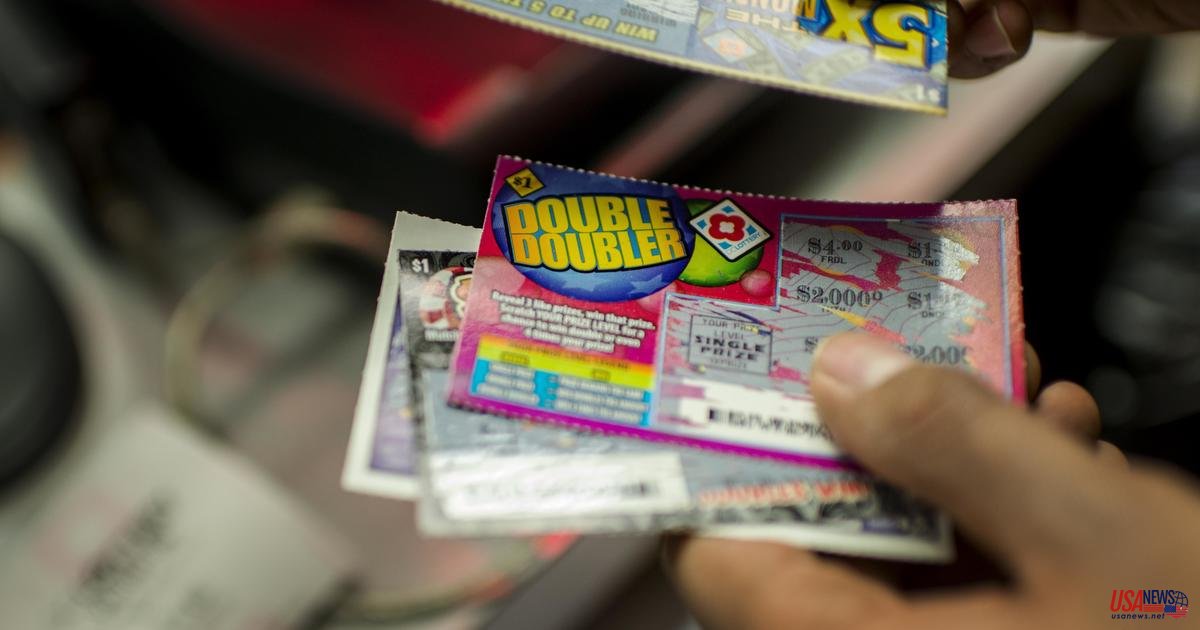The state lotteries have almost doubled in size over the past 20 years, resulting in a multibillion dollar wealth transfer from low-income communities in America to multinational corporations.
The Howard Center for Investigative Journalism at Maryland conducted a nationwide investigation into state lotteries. It found that lottery retailers tend to be concentrated in low-income areas in almost every state. Analyzing cellphone location data, the investigation found that those who patronize these stores are from the same communities.
Lotteries were once rare. They are now available in all 50 states. According to La Fleur's 2022 World Lottery Almanac, lottery ticket sales have increased from $47 billion up to $82 billion over the past five years, thanks to more than half-billion dollars annually in ad spend. Lotteries in 10 states generate more revenue per capita than corporate income taxes.
The investigation revealed that a promise made by lotteries in the US, that they support education, is not true. Lotteries can actually increase inequalities by benefiting students at college and wealthy school districts far away from the areas where most tickets are sold.
Gregory W. Sullivan, a former Massachusetts Inspector General and research director at a Boston-based free-market think tank, said that "poor people are collateral damage [to] a cause of raising funds for what the legislators believe is good purposes...public safety, local schools."
The multibillion-dollar wealth transfer begins in Warren, Michigan. Ashley Standifer purchases tickets in one the state's most poorest areas.
Standifer visited the Korner Party Store in Detroit's suburb of Detroit on a cold April day to purchase scratch-off tickets.
She purchases scratch tickets three times a day. She won $1,000 with a $3 scratch ticket four years ago. But she hasn’t won much since.
Standifer stated, "Ofcourse, you know, that I expect to get my money back," "But if I don't ... I'm still gonna buy it."
Standifer's spend is just a small portion of the $82 Billion annually spent by lottery players. This first input to a nearly national system that allows state-sponsored gambling directly into the majority of U.S. communities through more than 200,000 retail outlets.
Standifer, and millions of other players like her, lose approximately 35 cents per dollar.
Standifer stated that she had spent $130 yesterday and won $85, which is $45.
These losses, which average $29 billion per year in the US, are what make lotteries possible. These losses finance government programs and enrich others such as a Canadian private equity billionaire or a Japanese convenience-store conglomerate.
People believe that the lottery is funded by those who buy Powerball tickets when the jackpot becomes big. This is false reality.
Instant scratch-off tickets account for more than half of all lottery sales. These tickets range in price between $1 and $50. Only a small percentage of players spend most of this money.
According to a 1999 report by the National Gambling Impact Study Commission, the top 10% of lottery players accounted for nearly two-thirds (or ten percent) of all sales. According to the study, those with lower incomes were high school dropouts and people who are disproportionately Black.
Four times as much per year were high school dropouts than college graduates. Blacks spent on average five times more than Whites,
Massachusetts is one of the states that recognizes the importance of frequent players. According to a 2016 lottery study, the top 10% of players account in 40% of all sales. This group averaged nearly $200 in lottery spending per week.
According to a Howard Center-commissioned 2014 study, South Carolina players who have a household income below $35,000 per year spent twice as much than players with incomes between $100,000-150,000.
Cloyd White (26), a South Carolina construction worker, said that people will take 10-20 dollars each day to get to 100-400 dollars when they are down. It's a risky gamble, but it's worth it. I feel that it's all about God.
It also comes down to the choices that states make regarding who can sell lottery tickets.
Les Bernal, Stop Predatory Gambling's national director, stated that there is a reason so many lottery outlets are concentrated within low-income areas in the United States.
The Howard Center discovered that lotteries in the majority of US states have a high concentration of stores in areas with low education, income, and higher poverty rates. This is in contrast to communities that have larger numbers of Black and Hispanic residents.
Lotteries are not available in Nevada, Alabama, Hawaii, Utah, and Hawaii. Although the Howard Center couldn't obtain South Dakota lottery retailer locations, it did acquire them for 44 other states and Washington, D.C.
The analysis by the center found:
Standifer purchased her tickets at a store in a district with a poverty rate nearly three times that of Michigan. There are four lottery retailers in the area, and 28 more located in nearby neighborhoods.
The center's analysis revealed that neighborhoods with lottery retailers in Michigan have nearly twice the poverty rate than those without them.
According to the North American Association of State and Provincial Lotteries (an industry group), it is misleading to look at where stores are concentrated, because people don't always buy their lottery tickets within their own neighborhoods.
That's true. However, the Howard Center's first-of their kind analysis of mobile phone locations to study lottery retailers customers shows that they are mostly local.
Mobile location data was collected by SafeGraph, an intelligence company that tracks foot traffic to U.S. stores. The SafeGraph data aggregate shows the areas where customers live.
Marathon Gas Station in Warren, Michigan, just five minutes from Korner Party Store, where Standifer was a patron, sold more than $725,000 worth of lottery tickets in 2020. It is ranked among the top 20% of retailers in the state.
The average customer lives within 1.1 miles of its store and more than two-thirds of them live in the same area as the gas station.
The Howard Center analysis of store traffic patterns at almost three quarters of all U.S. lottery retail stores found similar patterns nationwide. Except for Arizona and Washington, D.C., the majority of lottery retailers had a local customer base.
Residents who visited Marathon's gas station had an average household income of $16,000 lower than Michigan's $57,000 median. The Howard Center studied 29 states and Washington, D.C. It found a similar gap in the analysis. In Washington, D.C., it found that the average household income for neighborhoods visiting lottery retailers was lower then the state's overall income.
Howard Center research found that states hire retailers based upon factors such as store security, ability to meet sales targets and compliance with advertising requirements in-store. The review did not find any evidence that states considered economic or racial inequity.
As a group, players lose. However, there are always winners: multinational companies that manage the lotteries for the states, large chain stores and advertising and media companies.
These entities, plus the state administrators who supervise the process, will retain more than a quarter of $29 billion that was lost by players.
Two private companies dominate the lottery industry: British-based International Game Technology PLC, and Canadian-owned Scientific Games Holdings LP.
Scientific Games' state-level lobbying in the 1980s was crucial to expanding the lottery from New Hampshire, 1964, to almost every state. Scientific Games has just sold its lottery business for $6 billion to Toronto-based private equity company Brookfield Business Partners LP. According to Forbes, Bruce Flatt (Brookfield CEO) will enjoy future profits. He is valued at $4.5 billion.
The commission stores receive for selling tickets or cashing in winning tickets is a commission. They make an average of 6% and can also receive substantial bonuses if a customer wins large. According to La Fleur's Almanac, they earned $5 billion in 2020.
Many states allow sales of products targeted at low-income clients. The Howard Center discovered that check-cashing shops, which are frequented by people with lower incomes who don't have bank accounts but still sell lottery tickets, in 24 states.
After the prizes have been paid and the costs associated with running the lottery are covered, $21 billion is left to spend on government programs. Education programs account for at least two-thirds the $21 billion.
Standifer is a Michigan lottery player. The Michigan lottery has been a win for education for many decades. The majority of state lottery funding goes to K-12 education funding.
Research shows that the state's education funding formula for students is not equitable. According to the Education Law Center's 2021 report, Michigan was given a grade "D" for its allocation of funding to low-poverty areas.
The report identified 15 states as being regressive. This meant that high-poverty areas received up to a third less per pupil than their low-poverty counterparts. Six of those states, Illinois, Michigan and Missouri, New Hampshire, Texas, have lotteries that at least partially finance K-12 education programs.
To fund college scholarships, some states use lottery revenues.
Nearly half of the lottery funding in Kentucky supports the Kentucky Educational Excellence Scholarship (KEES), a scholarship that awards money based upon a student’s GPA or test scores.
A Howard Center analysis of 2020 state scholarship data revealed that nearly 10% of Kentucky's high school students are Black. However, they received less than 5% of the KEES merit-based funding. An average White KEES recipient received $1,745, while an average Black KEES recipient received $1,244
This disparity was not evident in the state's need based scholarships where Black students received approximately 11% of the funds.
Abby Donahue (21), a University of Louisville senior, said that gambling is "designed to make you lose."
She said that college is expensive and that students are desperate for scholarships. They don't think about where their money comes from.
Standifer, and millions more like her, continue to play.
___
This story was contributed by Lauren Mowry, Jillian Diamond and Vanessa G. Sanchez, Howard Center reporters. Ethan Biddle, Isabel Tehan, Melissa Ellin and Isabel Tehan from Boston University also contributed to this story.













